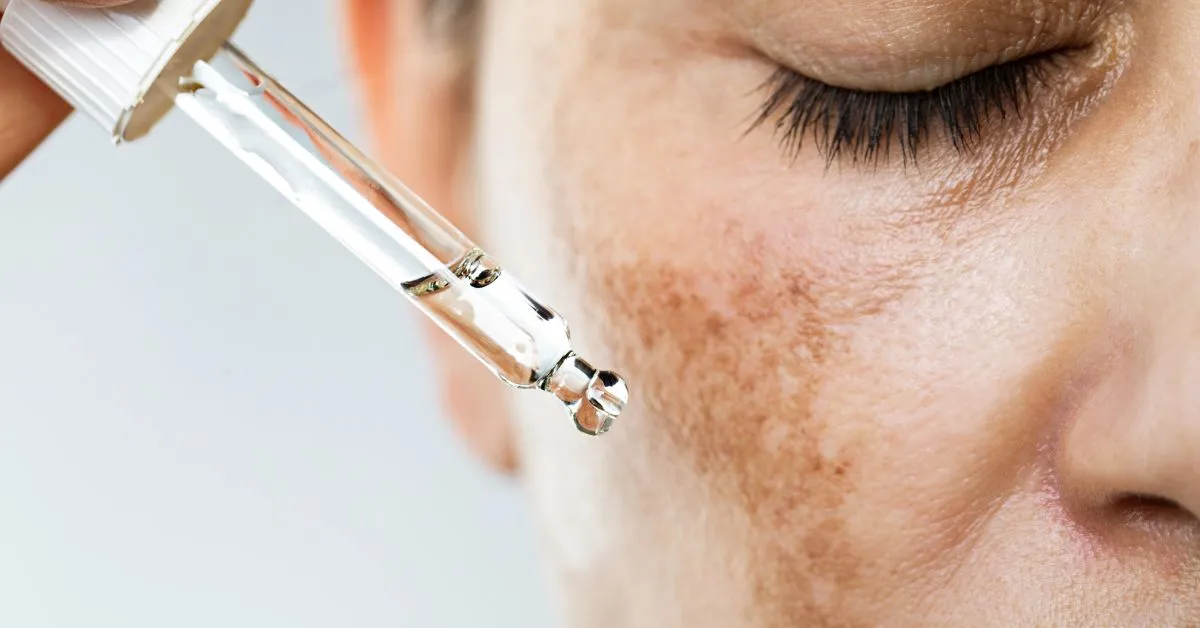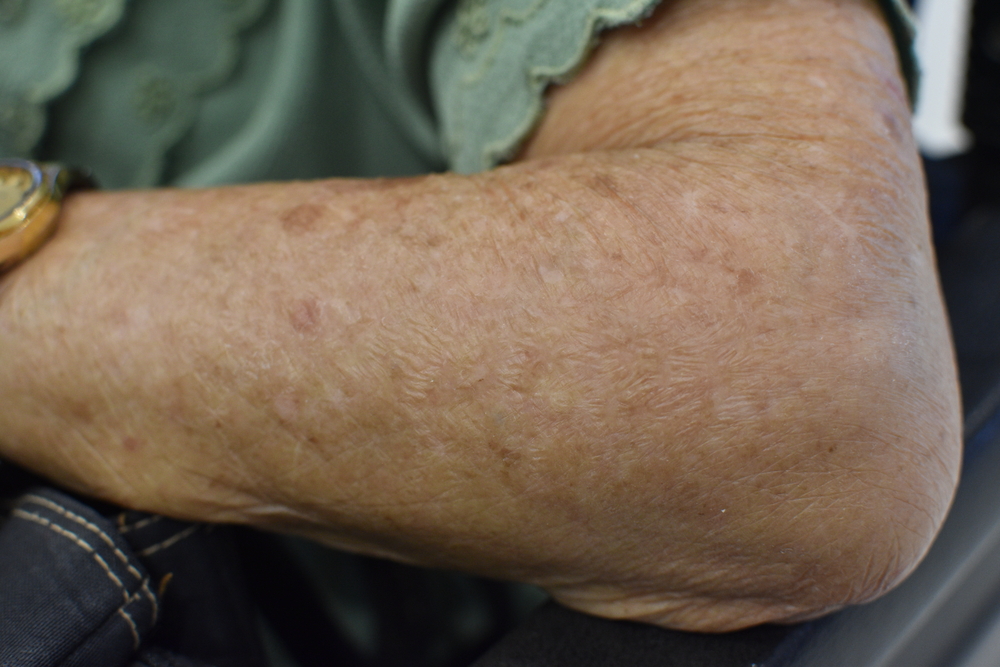One of the effective treatments for melasma is Tranexamic acid, which you can take in oral form or apply to the affected areas as a topical formulation (creams, serums, or gels).
However, it is widely seen that some medications might not suit certain individuals. So, to know more about the efficacy, side effects, and working mechanism of tranexamic acid for melasma, continue reading this blog until the end.
Melasma – An Overview
Melasma is a prevalent skin pigmentation issue that causes discolored and dark spots to appear mainly on chin, cheeks, forehead, nose bridge, and upper lip, neck and arms (areas that are exposed to the sun). Mostly, it is seen in the women population.
Even though the exact cause of melasma is not fully comprehended, it is believed to be related to a mixture of hormonal factors and genetics.
Exposure to the sun is also a major contributing aspect. The sun’s UV rays can trigger the production of melanin, which in turn, causes the skin to darken, leading to a hyperpigmentation condition. These dark spots may vary in size and shape and might be accompanied by little burning or itching sensations.
Usually, the remedy involves the use of chemical peels, topical treatment creams, and laser treatments. In fact, tranexamic acid is one of the best medications used to treat melasma.
Let’s dive in to learn about tranexamic acid for melasma treatment in detail!
Using Tranexamic Acid – Is It Good For The Skin?
Yes, tranexamic acid is good for the skin and in treating melasma. In fact, melasma is treated with topical hydroquinone (HQ) but is often refractory to the treatment. On the contrary, topical tranexamic acid is a better hydroquinone alternative.
As a matter of fact, tranexamic acid may be helpful for treating particular skin conditions such as melasma, hyperpigmentation, and post-inflammatory hyperpigmentation. It may also be employed to lessen the appearance of scars.
Further, tranexamic acid can also help to enhance the texture and overall skin appearance. It will help to even out the skin tone and decrease the appearance of fine lines and wrinkles. Do you want to know why? Because of its ability to increase collagen production, which is a crucial component in retaining healthy, youthful-looking skin.
However, it is important to use it after consulting a dermatologist. Follow the recommended dosage and usage instructions. Misuse or overuse might lead to adverse effects.
Types Of Tranexamic Acid – Oral TXA, Topical TXA
Let’s understand the two major types of tranexamic acid.
Oral TXA
- Taken by mouth, tranexamic acid pills are used to treat heavy menstrual bleeding and to reduce the risk of excessive bleeding during and after certain surgeries.
- Oral TXA can cause a few side effects, like diarrhea, nausea, and dizziness.
- It is difficult to purchase oral TXA without a prescription.
- There are chances that oral TXA might interact with a few other supplements and medications. So, always discuss this with your doctor before taking oral TXA.
- Oral tranexamic acid for melasma is effective because it can be taken by combining it with topical formulations and cosmetic treatments.
Topical TXA
- You can directly apply topical TXA on the skin (gel, cream, or solution).
- It is mostly used in the treatment of melasma and post-inflammatory hyperpigmentation as it acts as an anti-inflammatory agent.
- Topical TXA has less reported side effects and is mostly well-tolerated by the individuals.
- It has less chance of interacting with other medicines. Still, it is better to consult a doctor before applying.
- You can easily purchase topical TXA without a prescription because these are readily available as an over-the-counter product.
Does Tranexamic Acid Work For Melasma?
Tranexamic acid hinders the production of melanin, which is the pigment responsible for skin color. Melanin production is spurred by the action of an enzyme known as tyrosinase (TXA). TXA inhibits this particular enzyme, thereby lowering melanin production and enhancing skin discoloration.
A study estimated the effectiveness of TXA in combination with other treatments, such as glycolic acid and topical hydroquinone. It involved around 50 patients who were treated for a couple of weeks. You will be surprised to know that the results showed a substantial decline in melasma severity in all patients.
How To Use Tranexamic Acid For Melasma?
Depending on the severity, your dermatologist may recommend a suitable formulation of tranexamic acid for melasma.
- Follow the dosage instructions: Oral tranexamic acid for melasma dosage is 250-500mg two times a day for about 3-6 months.
- Use topical TXA as advised: You need to apply topical formulations (cream or serum) over the affected area as directed by the dermatologist. In fact, tranexamic acid cream for melasma is mostly applied twice daily. You need to use 3% to 5% TXA cream for almost 2 to 6 months to notice effective results.
- Try to protect your skin from the sun: Sun exposure aggravates melasma. Hence, it is crucial to protect the skin and follow a skin care regimen by applying a broad-spectrum sunscreen (SPF 30 or more).
- Be consistent: Tranexamic acid might take several weeks or months to show positive results. Thus, the key is to be patient and consistent! Follow your dermatologist’s advice and do regular follow-ups.
Will Melasma Come Back After Tranexamic Acid?
The clinical efficacy of tranexamic acid for melasma depends on a few factors, such as the severity of the disorder and the underlying issues.
In most cases, patients experience a relapse after stopping the use of tranexamic acid. Thus, it is better to consult your doctor and get the necessary information before using or stopping tranexamic acid for melasma. Reach out to your dermatologist if you experience relapse or any other symptoms.
How Long Can You Take Tranexamic Acid For Melasma?
Tranexamic acid for melasma treatment depends on the severity of the condition and how well the medication is working.
Oral TXA – It has shown efficacy for melasma in Asian skin, even in low doses (e.g.500 mg daily) over a short period of time (8-12 weeks).
Topical TXA – You need to use it for at least 12 weeks to notice effective results. Along with that, avoiding sun exposure is a must! And regular application of sunscreen (SPF 30) is a sine qua non!
Side Effects Of Tranexamic Acid For Melasma
Even though patients use tranexamic acid for melasma widely as an effective treatment, it does possess some side effects.
Skin Related
- Skin irritation
- Itching
- Redness
- Dryness
Others
- Headaches
- Nausea
- Vomiting
- Diarrhea
- Dizziness
- Visual disturbances
- Abdominal pain
- Muscle weakness
Few Allergic Reactions
- Hives
- Swelling of the lips, face, throat, or tongue
- Difficulty breathing
Thus, you need to consult with your dermatologist before taking this medication. Always make it a point to discuss your health issues and allergies with the doctor.
Which Is Better – Hydroquinone Or Tranexamic Acid?
Randomized controlled trials were conducted in which people suffering from melasma were included ranging from 18 to 50 years. Around 100 females used tranexamic acid (5%) on the ride side of their face and 4% topical hydroquinone (HQ) on their left side.
After 12 weeks of undergoing the treatment, it was noticed that both TA 5% and HQ 4% creams delivered significant results. Nevertheless, a considerable reduction in the area % of melanin was noticed on the side where TA 5% was applied.
Undoubtedly, you can conclude that TA is a favorable therapeutic option to treat melasma with less adverse side effects, providing better results than HQ cream.
Conclusion
After going through the above write-up, you must have understood the efficacy of tranexamic acid for melasma treatment.
TXA, indeed, is a promising treatment for melasma, with studies indicating that it can decrease the severity of melasma and improve the appearance of the skin. You can well-tolerate it as it has few side effects. Nonetheless, it is essential to consult a dermatologist before using tranexamic acid for melasma, as it may not suit everyone.
FAQs
A: Yes, you can use tranexamic acid alone for melasma treatment, and it has shown promising results in clinical studies. Also, you can combine it with other cosmetic and topical treatments.
A: It can take several weeks for tranexamic acid to start working for melasma. Results might vary depending on the severity of the condition.
A: Generally, it is not recommended as there is limited research on its safety during pregnancy and lactation. It’s better to consult a healthcare professional before you start taking this medication.









